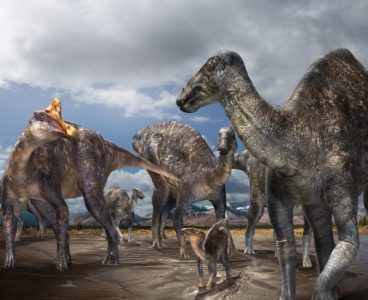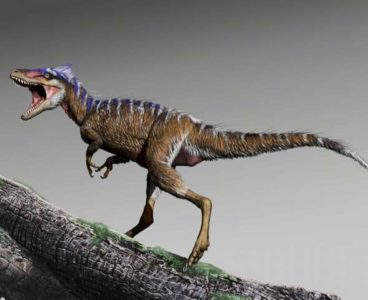During the Iron Age around 300 AD something extraordinary was initiated in Levänluhta area in Isokyrö, SW Finland. The deceased were buried in a lake, and this habit was continued for at least 400 years. When trenches were dug in the local fields in mid-1800’s skulls and other human bones were surfacing. These bones had…
Traces of Crawling in Italian Cave Give Clues to Ancient Humans’ Social Behavior
Evidence of crawling in an Italian cave system sheds new light on how late Stone Age humans behaved as a group, especially when exploring new grounds, says a study published today in eLife. The cave of Bàsura at Toirano and its human and animal fossil traces have been known since the 1950s, with the first…
Freshwater Mussel Shells Were Material of Choice For Prehistoric Craftsmen
A new study suggests that 6000-years-ago people across Europe shared a cultural tradition of using freshwater mussel shells to craft ornaments. An international team of researchers, including academics from the University of York, extracted ancient proteins from prehistoric shell ornaments – which look remarkably similar despite being found at distant locations in Denmark, Romania and…
Middle Pleistocene Human Skull Reveals Variation and Continuity in Early Asian Humans
A team of scientists led by LIU Wu and WU Xiujie from the Institute of Vertebrate Paleontology and Paleoanthropology (IVPP) of the Chinese Academy of Sciences reported the first ever Middle Pleistocene human skull found in southeastern China, revealing the variation and continuity in early Asian humans. Their findings were published on April 30 in…
New Fossil Evidence Claims First Discovery of Taro in Maori Gardens
The first discovery of Polynesian taro grown in Māori gardens in the 1400s can be claimed by an archaeological research project on Ahuahu-Great Mercury Island. Jointly carried out by the University of Auckland and Auckland War Memorial Museum, the project’s new evidence displays the sophistication with which early Māori first utilised the New Zealand environment,…
First-Confirmed Occurrence of a Lambeosaurine Dinosaur Found on Alaska’s North Slope
Paleontologists from Hokkaido University in Japan, in cooperation with paleontologists from the Perot Museum of Nature and Science in Dallas, Texas, have discovered the first-confirmed occurrence of a lambeosaurine (crested ‘duck-billed’ dinosaur) from the Arctic – part of the skull of a lambeosaurine dinosaur from the Liscomb Bonebed (71-68 Ma) found on Alaska’s North Slope.…
Neanderthals Walked Upright Just Like the Humans of Today
Neanderthals are often depicted as having straight spines and poor posture. However, these prehistoric humans were more similar to us than many assume. University of Zurich researchers have shown that Neanderthals walked upright just like modern humans, thanks to a virtual reconstruction of the pelvis and spine of a very well-preserved Neanderthal skeleton found in…
New Species of Tiny Tyrannosaur Foreshadows Rise of T. Rex
A newly discovered, diminutive—by T. rex standards—relative of the tyrant king of dinosaurs reveals crucial new information about when and how T. rex came to rule the North American roost. Meet Moros intrepidus, a small tyrannosaur who lived about 96 million years ago in the lush, deltaic environment of what is now Utah during the…
First Neanderthal Footprints Found in Gibraltar
The prestigious international journal Quaternary Science Reviews has just published a paper which has involved the participation of Gibraltarian scientists from The Gibraltar National Museum alongside colleagues from Spain, Portugal and Japan. The results which have been published come from an area of the Catalan Bay Sand Dune. This work started ten years ago, when…
Centuries-Old Population Movements Revealed in Fine-Scale Genetic Map of the Iberian Peninsula
New Studies Reveal Deep History of Archaic Humans in Southern Siberia
Oxford University scientists have played a key role in new research identifying the earliest evidence of some of the first known humans—Denisovans and Neanderthals, in Southern Siberia. Professor Tom Higham and his team at the Oxford Radiocarbon Accelerator Unit at the University of Oxford worked in collaboration with a multi-disciplinary team from the UK, Russia,…
Fossil Deposit is Much Richer Than Expected
It has long been known that a quarry near the Dutch town of Winterswijk is an Eldorado for fossil lovers. But even connoisseurs will be surprised just how outstanding the site actually is. A student at the University of Bonn, himself a Dutchman and passionate fossil collector, has now analyzed pieces from museums and private…
Skull Scans Tell Tale of How World’s First Dogs Caught Their Prey
Analysis of the skulls of lions, wolves and hyenas has helped scientists uncover how prehistoric dogs hunted 40 million years ago. A study has revealed that the first species of dog – called Hesperocyon gregarius – pounced on its prey in the same way that many species, including foxes and coyotes, do today. The findings…
Archeological Discovery Yields Clues to How Our Ancestors May Have Adapted to Their Environment
Paleontologists Piece Together Massive New Dinosaur from Vertebrae Bones
The Volgatitan has now joined the ranks of dinosaurs in the Sauropod family. Paleontologists from the Akson Russian Science Communication Association have gathered together the final puzzle pieces for a new dinosaur from seven caudal vertebrae bones that had remained in the ground for the last 130 million years on the banks of the Volga…
Scientists Discover Possible Mantle Mineral
Study Uses Rings in Teeth to Understand the Environment Neanderthals Faced
Scientists are painting the clearest picture yet of what life may have been like for Neanderthals living in Southern France some 250,000 years ago, and to do it, they’re using an unlikely day-to-day record of what their environment was like—their teeth. A team of researchers showed that examining the teeth of Neanderthal infants could yield…
The Engineering Work of Ants Can Influence Paleoclimatic Studies
Ants of the species Messor barbarus modify the grain size and mineralogical composition of the soils they inhabit, influencing the results obtained in palaeoclimatic and palaeoenvironmental studies, according to research conducted by the Complutense University of Madrid (UCM), the National Museum of Natural Sciences (MNCN), the Institute of Geosciences (CSIC, UCM) and the Doñana Biological…
Late Miocene Ape Maxilla Discovered in Western India
An ape maxilla (upper jaw) from the Late Miocene found in the Kutch basin, in western India, significantly extends the southern range of ancient apes in the Indian Peninsula, according to a study published in November 14, 2018 in the open-access journal PLOS ONE by Ansuya Bhandari from the Birbal Sahni Institute of Palaeosciences, Lucknow,…
Scientists Theorize New Origin Story for Earth’s Water
Earth’s water may have originated from both asteroidal material and gas left over from the formation of the Sun, according to new research. The new finding could give scientists important insights about the development of other planets and their potential to support life. In a new study in the Journal of Geophysical Research: Planets, a…
Enhanced Views of Earth Tectonics
Scientists from Germany’s Kiel University and British Antarctic Survey (BAS) have used data from the European Space Agency (ESA), Gravity field and steady-state Ocean Circulation Explorer (GOCE) mission to unveil key geological features of the Earth’s lithosphere – the rigid outer layer that includes the crust and the upper mantle. Published this week in the…
Scientists Discover the Origins of Chocolate
Newly Described Fossils Could Help Reveal Why Some Dinos Got so Big
By the time non-avian dinosaurs went extinct, plant-eating sauropods like the Brontosaurus had grown to gargantuan proportions. Weighing in as much as 100 tons, the long-neck behemoths are the largest land animals to ever walk the earth. How they grew so large from ancestors that were small enough to be found in a modern-day petting…
Researchers Add Surprising Finds to the Fossil Record
A newly discovered fossil suggests that large, flowering trees grew in North America by the Turonian age, showing that these large trees were part of the forest canopies there nearly 15 million years earlier than previously thought. Researchers from Adelphi University and the Burpee Museum of Natural History found the fossil in the Mancos Shale…

























